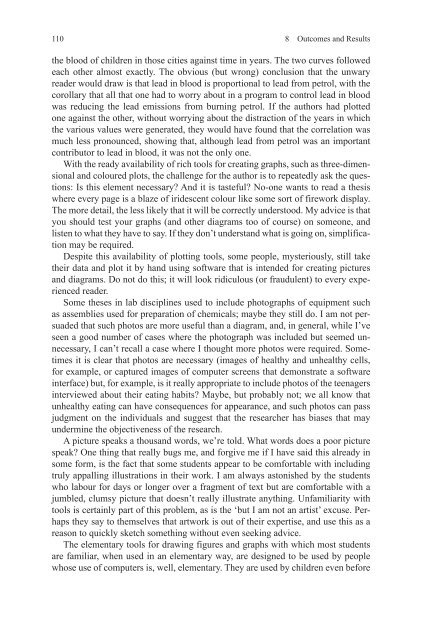How-to-Write-a-Better-Thesis
Create successful ePaper yourself
Turn your PDF publications into a flip-book with our unique Google optimized e-Paper software.
110 8 Outcomes and Results<br />
the blood of children in those cities against time in years. The two curves followed<br />
each other almost exactly. The obvious (but wrong) conclusion that the unwary<br />
reader would draw is that lead in blood is proportional <strong>to</strong> lead from petrol, with the<br />
corollary that all that one had <strong>to</strong> worry about in a program <strong>to</strong> control lead in blood<br />
was reducing the lead emissions from burning petrol. If the authors had plotted<br />
one against the other, without worrying about the distraction of the years in which<br />
the various values were generated, they would have found that the correlation was<br />
much less pronounced, showing that, although lead from petrol was an important<br />
contribu<strong>to</strong>r <strong>to</strong> lead in blood, it was not the only one.<br />
With the ready availability of rich <strong>to</strong>ols for creating graphs, such as three-dimensional<br />
and coloured plots, the challenge for the author is <strong>to</strong> repeatedly ask the questions:<br />
Is this element necessary? And it is tasteful? No-one wants <strong>to</strong> read a thesis<br />
where every page is a blaze of iridescent colour like some sort of firework display.<br />
The more detail, the less likely that it will be correctly unders<strong>to</strong>od. My advice is that<br />
you should test your graphs (and other diagrams <strong>to</strong>o of course) on someone, and<br />
listen <strong>to</strong> what they have <strong>to</strong> say. If they don’t understand what is going on, simplification<br />
may be required.<br />
Despite this availability of plotting <strong>to</strong>ols, some people, mysteriously, still take<br />
their data and plot it by hand using software that is intended for creating pictures<br />
and diagrams. Do not do this; it will look ridiculous (or fraudulent) <strong>to</strong> every experienced<br />
reader.<br />
Some theses in lab disciplines used <strong>to</strong> include pho<strong>to</strong>graphs of equipment such<br />
as assemblies used for preparation of chemicals; maybe they still do. I am not persuaded<br />
that such pho<strong>to</strong>s are more useful than a diagram, and, in general, while I’ve<br />
seen a good number of cases where the pho<strong>to</strong>graph was included but seemed unnecessary,<br />
I can’t recall a case where I thought more pho<strong>to</strong>s were required. Sometimes<br />
it is clear that pho<strong>to</strong>s are necessary (images of healthy and unhealthy cells,<br />
for example, or captured images of computer screens that demonstrate a software<br />
interface) but, for example, is it really appropriate <strong>to</strong> include pho<strong>to</strong>s of the teenagers<br />
interviewed about their eating habits? Maybe, but probably not; we all know that<br />
unhealthy eating can have consequences for appearance, and such pho<strong>to</strong>s can pass<br />
judgment on the individuals and suggest that the researcher has biases that may<br />
undermine the objectiveness of the research.<br />
A picture speaks a thousand words, we’re <strong>to</strong>ld. What words does a poor picture<br />
speak? One thing that really bugs me, and forgive me if I have said this already in<br />
some form, is the fact that some students appear <strong>to</strong> be comfortable with including<br />
truly appalling illustrations in their work. I am always as<strong>to</strong>nished by the students<br />
who labour for days or longer over a fragment of text but are comfortable with a<br />
jumbled, clumsy picture that doesn’t really illustrate anything. Unfamiliarity with<br />
<strong>to</strong>ols is certainly part of this problem, as is the ‘but I am not an artist’ excuse. Perhaps<br />
they say <strong>to</strong> themselves that artwork is out of their expertise, and use this as a<br />
reason <strong>to</strong> quickly sketch something without even seeking advice.<br />
The elementary <strong>to</strong>ols for drawing figures and graphs with which most students<br />
are familiar, when used in an elementary way, are designed <strong>to</strong> be used by people<br />
whose use of computers is, well, elementary. They are used by children even before














![[Lonely Planet] Sri Lanka](https://img.yumpu.com/59845622/1/169x260/lonely-planet-sri-lanka.jpg?quality=85)


